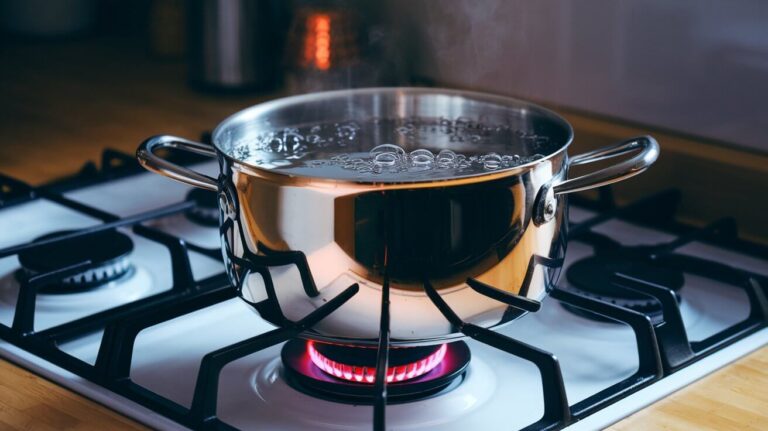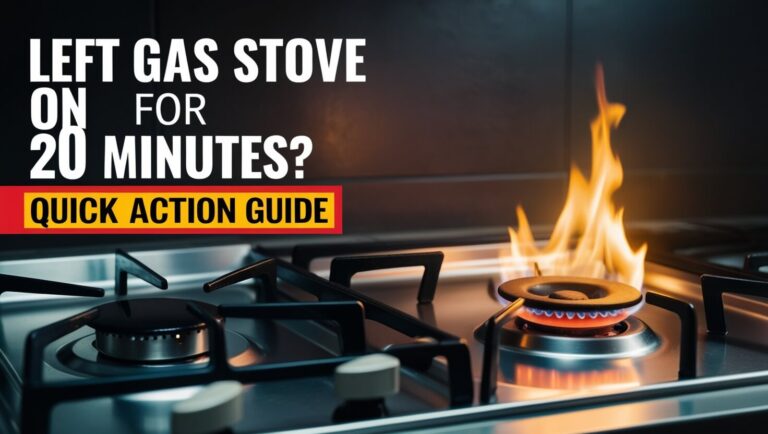
A gas stove pilot light that’s always on is a common feature in older models, designed to provide instant ignition for the burners. While it offers convenience, it also raises questions about safety, energy efficiency, and maintenance. This guide explores the ins and outs of constantly burning pilot lights, their pros and cons, and what you can do if you’re dealing with one in your kitchen.
The Purpose of a Pilot Light in Gas Stoves
Pilot lights play a crucial role in gas stoves. They’re small, continuous flames that ignite the main burners when you turn on your stove. But why are they always on? Let’s break it down.
How a Pilot Light Works
A pilot light is a tiny flame that burns non-stop. It’s fed by a small amount of gas from your stove’s main supply. When you turn a burner knob, it opens a valve. This lets gas flow to the burner. The pilot light then ignites this gas, giving you a cooking flame.
The system is simple but effective. It ensures your stove is ready to use at a moment’s notice. No waiting for ignition or fumbling with matches. Just turn the knob, and you’re cooking with gas.
Benefits of a Constantly Burning Pilot Light
Always-on pilot lights offer several advantages:
- Instant ignition: Your burners light up immediately when you turn them on.
- Reliability: They work even during power outages.
- Simplicity: The mechanism is straightforward, with fewer parts that can break down.
- Moisture control: The constant heat helps prevent rust in the stove’s internal parts.
These benefits made pilot lights a popular choice in older gas stoves. However, they’re not without drawbacks.
Safety Concerns with an Always-On Pilot Light
While convenient, constantly burning pilot lights raise some safety issues. It’s important to understand these risks to use your stove safely.
Gas Consumption and Energy Efficiency
A pilot light that’s always on consumes gas 24/7. This continuous use can add up over time. The U.S. Department of Energy estimates that pilot lights in gas appliances can waste up to $50 worth of gas annually.
This constant gas use isn’t just a hit to your wallet. It’s also not great for the environment. Reducing unnecessary gas consumption is one way to lower your carbon footprint.
Carbon Monoxide Risks
Carbon monoxide (CO) is a serious concern with gas appliances. This odorless, colorless gas can be deadly in high concentrations. A properly functioning pilot light produces minimal CO. But if something goes wrong, it can become a hazard.
Poor ventilation or a malfunctioning pilot light can lead to CO buildup. That’s why it’s crucial to have working CO detectors in your home if you have gas appliances.
Fire Hazards
An always-on flame, even a small one, presents a fire risk. If flammable materials come into contact with the pilot light, they could ignite. This risk increases if the stove isn’t properly maintained or if there’s a gas leak.
Regular checks and proper stove placement can minimize this risk. But it’s something to be aware of, especially in homes with curious pets or small children.
Troubleshooting a Pilot Light That Won’t Turn Off
Sometimes, a pilot light that won’t turn off isn’t by design. It could be a sign of a problem. Here’s what to look out for and how to address it.
Common Causes of a Constantly Burning Pilot Light
Several issues can cause a pilot light to stay on when it shouldn’t:
- Faulty thermocouple: This safety device shuts off gas if the pilot light goes out. If it’s broken, the gas keeps flowing.
- Stuck gas valve: A valve that won’t close properly keeps feeding gas to the pilot light.
- Improper adjustment: Sometimes, the pilot light is set too high, making it seem like it’s always on.
- Dirty pilot orifice: Buildup can cause the flame to burn irregularly or constantly.
Identifying the cause is the first step in fixing the problem.
DIY Fixes for Pilot Light Issues
Some pilot light problems are simple enough to tackle yourself:
- Clean the pilot orifice: Use a needle or thin wire to clear any debris.
- Adjust the flame: If it’s too high, turn down the pilot light adjustment screw.
- Check for drafts: Strong airflow can make the pilot light seem like it’s always on.
- Inspect the thermocouple: Make sure it’s positioned correctly in the pilot flame.
Remember, safety first. If you smell gas or aren’t confident in your DIY skills, call a professional.
Modern Alternatives to Always-On Pilot Lights
Technology has given us alternatives to the traditional always-on pilot light. These newer systems offer improved safety and efficiency.
Electronic Ignition Systems
Many modern gas stoves use electronic ignition. This system creates a spark to light the burner when you turn it on. There’s no constant flame. Instead, it uses electricity to ignite the gas as needed.
Benefits of electronic ignition include:
- Energy savings: No gas is used when the stove is off.
- Improved safety: No open flame when the stove isn’t in use.
- Easy start: Just turn the knob, and the burner lights automatically.
The downside? These systems rely on electricity. They won’t work during a power outage unless your stove has a battery backup.
Intermittent Pilot Ignition
Intermittent pilot ignition is a middle ground between always-on pilots and electronic ignition. This system lights a pilot flame only when you turn on a burner. Once the burner is lit, the pilot goes out.
This method offers:
- Energy efficiency: No constant gas use.
- Reliability: Works without electricity.
- Safety: No standing pilot light when the stove isn’t in use.
It combines the best of both worlds, offering convenience and efficiency.
Maintaining Your Gas Stove’s Pilot Light
Proper maintenance is key to keeping your gas stove safe and efficient, especially if it has an always-on pilot light.
Regular Cleaning Tips
Clean pilot lights work better and safer. Here’s how to keep yours in top shape:
- Turn off the gas before cleaning.
- Use a soft brush to remove debris from the pilot opening.
- Clear the orifice with a thin wire or needle.
- Wipe down the area around the pilot light.
- Check that all parts are dry before turning the gas back on.
Regular cleaning prevents buildup that can affect the pilot light’s performance.
When to Call a Professional
Some issues are best left to the experts. Call a professional if:
- You smell gas.
- The pilot light repeatedly goes out.
- The flame is yellow or orange instead of blue.
- You’re not comfortable working with gas appliances.
A qualified technician can safely diagnose and fix more complex problems.
The Future of Gas Stove Technology
Gas stove technology is evolving. New innovations are making these appliances safer, more efficient, and smarter.
Innovations in Gas Stove Design
Recent advancements include:
- Flame failure devices: These shut off gas flow if the flame goes out.
- Smart controls: Wi-Fi-enabled stoves let you monitor and control them remotely.
- Improved burner design: New burners offer more precise temperature control and better energy efficiency.
- Dual fuel options: These stoves combine gas cooktops with electric ovens for versatility.
These innovations address many of the concerns associated with traditional gas stoves and their pilot lights.
Energy-Efficient Options for Homeowners
If you’re in the market for a new stove, consider these energy-efficient options:
- Induction cooktops: They use electromagnetic fields to heat pots directly, offering speed and efficiency.
- Electric ranges with convection ovens: These provide even heating and can be powered by renewable energy.
- High-efficiency gas models: Look for the ENERGY STAR label for the most efficient gas options.
While these may not use traditional pilot lights, they offer modern solutions to cooking needs.
Conclusion
The best stove is one that works for you and is safe to use. If you have an old gas stove with a pilot light, take good care of it. Clean it often and get help if something seems wrong. If you’re buying a new stove, think about what you need. Look at gas, electric, and mixed options. New stoves are safer and use less energy. But with good care, even old gas stoves can last a long time.






